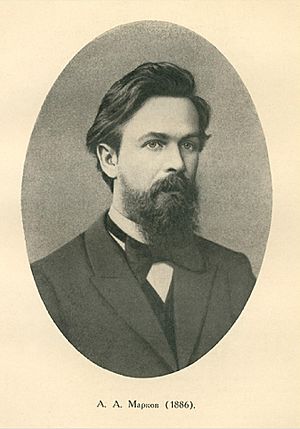Andrey Markov facts for kids
Quick facts for kids
Andrey Andreyevich Markov
|
|
|---|---|

Markov in 1886
|
|
| Born | 14 June 1856 N.S. Ryazan, Russian Empire
|
| Died | 20 July 1922 (aged 66) |
| Nationality | Russian |
| Alma mater | St. Petersburg University |
| Known for | Markov chains; Markov processes; stochastic processes |
| Children | Andrey Markov Jr. |
| Scientific career | |
| Fields | Mathematics, specifically probability theory and statistics |
| Institutions | St. Petersburg University |
| Doctoral advisor | Pafnuty Chebyshev |
| Doctoral students |
|
Andrey Andreyevich Markov (born June 14, 1856 – died July 20, 1922) was a famous Russian mathematician. He is best known for his important work on stochastic processes. These are mathematical models that describe things that change randomly over time. One of his main discoveries was later called the Markov chain.
A Markov chain is a special type of mathematical model. It helps us understand systems where the future depends only on the current state. It does not depend on how the system got to that state. Think of it like a game where your next move only depends on where you are right now. It doesn't matter what moves you made before.
Andrey Markov and his younger brother, Vladimir Andreevich Markov, also proved a mathematical rule. It is known as the Markov brothers' inequality. Andrey Markov's son, also named Andrey Andreyevich Markov, became a notable mathematician too. He worked on different areas of mathematics.
About Andrey Markov
Andrey Markov was born in Russia on June 14, 1856. As a student, he went to the St. Petersburg Grammar School. Some of his teachers thought he was a bit rebellious. He wasn't great at all subjects, but he was really good at mathematics.
Later, he studied at Saint Petersburg Imperial University. This university is now called Saint Petersburg State University. He learned from many brilliant mathematicians there. After finishing his studies, he was asked to stay and become a mathematician. He taught at high schools and kept doing his own math research.
Markov found a cool way to use his math skills. He used his "chains" idea to study how vowels and consonants appeared in Russian literature. He looked at patterns in words and sounds. He made many other important contributions to mathematics during his life. He passed away on July 20, 1922, when he was 66 years old.
Markov's Career Highlights
In 1877, Markov won a gold medal for solving a difficult math problem. The next year, he passed his exams to become a lecturer at the university.
In 1880, Markov completed his master's thesis. This was a big research paper on "Binary Square Forms." Four years later, in 1884, he finished his doctoral thesis. This paper was about "Algebraic Continuous Fractions."
Markov started teaching after he finished his master's thesis. He taught different types of calculus. He also took over teaching probability theory from his former teacher, Pafnuty Chebyshev.
In 1886, Markov became an extraordinary professor. He was also elected to the Academy of Sciences. By 1894, he became a full professor at St. Petersburg University. In 1896, he became a full member of the Academy.
In 1905, Markov was given the right to retire. He did so right away. However, he continued to give lectures until 1910.
Markov was a man of strong principles. In 1908, university professors were asked to watch their students closely. This was because of student protests. Markov refused to do this. He said he would not be an "agent of the governance." Because of this, he was removed from teaching duties. He then decided to retire from the university.
Markov was known for his independent thinking. In 1912, he disagreed with the Russian Orthodox Church. He asked to be removed from the church. The church agreed to his request.
In 1913, St. Petersburg University wanted to make Markov an honorary member. But the minister of education did not approve it. This approval finally happened in 1917, after the February Revolution. Markov then returned to teaching. He taught probability theory until he passed away in 1922.
Images for kids
See also
 In Spanish: Andréi Márkov para niños
In Spanish: Andréi Márkov para niños
- List of things named after Andrey Markov
- Chebyshev–Markov–Stieltjes inequalities
- Gauss–Markov theorem
- Gauss–Markov process
- Hidden Markov model
- Markov blanket
- Markov chain
- Markov decision process
- Markov's inequality
- Markov brothers' inequality
- Markov information source
- Markov network
- Markov number
- Markov property
- Markov process
- Stochastic matrix (also known as Markov matrix)
- Subjunctive possibility



